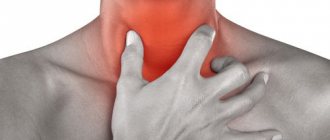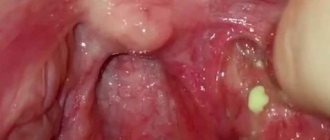A constant unpleasant feeling of a lump in the throat, including when swallowing, associated with belching and lack of air, can be a manifestation of several different diseases. The sensation is often accompanied by discomfort when inhaling and a feeling of pressure.
Specialists from the First Family Clinic of St. Petersburg will help you find the true reasons for the sensation of a lump in your throat.
How does a lump in the esophagus manifest itself?
A lump in the esophagus is a very unpleasant sensation
A description of this symptom is found in the works of the great ancient physician Hippocrates. He considered a lump in the esophagus to be a manifestation of hysterical natures. Since then, the idea of a coma in the esophagus has changed somewhat. It is characterized by the following signs:
- Difficulty swallowing and breathing.
- Sensation of a foreign body in the area of the esophagus.
- Constant desire to cough, to swallow obstruction.
- Feeling of lack of air, suffocation.
- Fear of suffocation, choking (especially in sleep).
- Hoarseness, pain when talking or eating.
Such sensations are not always permanent; they can manifest themselves after taking a certain body position, or after eating, mental stress, or the appearance of strong emotions.
The influence of nervous tension on the appearance of unpleasant symptoms in the esophagus
If such a symptom appears infrequently and is not associated with food intake, it can be assumed that the lump in the throat is caused by mental characteristics, in particular, a tendency to hysteria. With nervous tension associated with anxiety, excitement, or stress, a sensation of a lump appears closer to the pharynx in the area of the esophagus, which is usually called “hysterical”.
After a short period of time, everything usually goes away without any drug intervention or complications. Subsequently, in such cases, you can do several breathing exercises, massage the collar area, and take a mild sedative. Even a simple change of environment will help get rid of this symptom.
A lump in the esophagus may also be psychogenic in nature
From a physiological point of view, this reaction of the body is explained by the fact that during stress the body needs a large amount of oxygen. In this case, the glottis becomes so wide that it cannot be completely covered by the epiglottis. As a result, it is impossible to utter a word, swallow tears, or take a breath.
If the feeling of a coma in the esophagus is accompanied by panic attacks and mood swings, it is necessary to take sedatives, antidepressants, and consult a psychotherapist. The prerogative of a neurologist will be to treat a lump in the throat if it is accompanied by:
- Dizziness
- Nausea
- Apathy
- Increased sensitivity to weather fluctuations.
In this case, we are talking about vegetative-vascular dystonia, which has recently become the scourge of the modern city dweller. Dysfunction of the nervous system manifests itself in this way. If someone in the esophagus experiences pain between the ribs, which intensifies with exercise, as well as with inhalation and exhalation, we may be talking about intercostal neuralgia - inflammation of the nerve responsible for the innervation of the chest.
Feeling of a lump in the throat with VSD
Very often you can find in people suffering from VSD the sensation of a lump in the throat. It's one thing when there is a logical, although there may be an unpleasant and frightening explanation, for example, a tumor or severe inflammation that causes a narrowing of the larynx. But what to do in cases where there is a lump, but there are no reasons for it, and turning to a variety of specialists gives the same result: the person who contacts them has no reason to feel a lump.
What are the symptoms of a lump in the throat?
This symptom of VSD, like a lump in the throat, appears completely suddenly. One fine morning there is a feeling that something is interfering, preventing you from swallowing and breathing deeply as usual. At the same time, five minutes ago everything was in order, but any ordinary or everyday situation, accompanied by a little excitement, an increase in blood pressure and an increase in heart rate - and now, the feeling that someone is squeezing the neck. All you have to do is drink a sedative, come to your senses a little, and your condition will return to normal. But in any other stressful situation, the feeling of a lump in the throat appears again.
Unpleasant sensations can be either constant or periodic. At the same time, the sensations may differ from person to person; it may be a tickling sensation, a tingling sensation, a feeling of squeezing, or the inability to swallow, whether it is saliva or solid food.
Sometimes the feeling of a lump can develop into a state in which a person may realize that he has forgotten how to swallow and cannot do it. Then it comes to a panic attack. So, over time, a fear of swallowing in general and eating solid food may develop.
Causes of a lump in the throat with VSD
Vegetative-vascular dystonia in itself is a nervous disorder; suffering from VSD, a person is constantly in panic and fear of something. This, in turn, is triggered by the release of large doses of adrenaline into the blood.
Which part of the body the adrenaline will choose to express itself is not clear. For some, this manifests itself in pain in the chest area, for others, the gastrointestinal tract suffers, and for others, they experience spasms of the laryngeal muscles, which is the very sensation of a lump in the throat.
It is worth remembering that no other disease, for example, an enlarged thyroid gland, osteochondrosis or aneurysm, gives symptoms similar to a coma, no matter what anyone says.
What could be bothering your throat?
People who first feel a lump in their throat first think of the worst, of course, cancer. What else could create such sensations of interference if not a tumor? And the more panic moods grow in a person, the stronger the lump is felt.
You need to know that the most important difference between a lump in the throat during VSD and any serious disease of the larynx, esophagus or other respiratory organs is that during sleep the lump is not felt at all. When I wake up, everything is fine too. But as soon as you get up and feel more energetic, the sensations return. The whole point here is that until the brain woke up, the body felt good, but as soon as the brain returned to working condition, it remembered that there should be a lump, and the patient felt it again.
It is the normal state of the throat in the first five minutes after waking up that should assure a person that the issue here is not some mythical disease, but the state of the nervous system.
How to treat a lump in the throat?
In fact, it is very difficult for any person suffering from VSD to admit to himself that the problem is not a disease at all, but a disorder of the nervous system. Treatment for coma is the same as for VSD therapy.
- Taking psychotropic medications that reduce panic attacks to a minimum and have a calming effect in a dosage that is relevant for a particular patient.
- An attempt to come to terms with the fear of death and liberation from oppressive terrible thoughts. You can seek advice on this issue from a psychotherapist, but you will have to work on yourself on your own.
The feeling of a lump in the throat will not go away on its own and will poison your life.
He needs to be treated. Author: K.M.N., Academician of the Russian Academy of Medical Sciences M.A. Bobyr
Thyroid problems and esophageal conditions
Pathologies of the thyroid gland associated with its increased or decreased function (hypothyroidism and hyperthyroidism) can cause a feeling of a lump in the esophagus. If, at the same time as this symptom, you experience irritability, a feeling of chilliness, or, conversely, constant sweating, dry and brittle nails, hair, and memory impairment, you may need to consult an endocrinologist. Causes of thyroid dysfunction:
- Hormonal changes in the body.
- Iodine deficiency in food and drinking water.
- Metabolic disorders.
To clarify the diagnosis, you will have to do an ultrasound of the thyroid gland and donate blood for the presence of its hormones.
Physical causes of a lump in the throat
- Impact to the neck, injury;
- Entry of a foreign body;
- Diseases of the trachea or esophagus;
- Inflammatory processes in the larynx and oral cavity;
- Stomach diseases;
- Cardiovascular diseases;
- Infections;
- Thyroid disease;
- Other somatic disorders.
Where to begin
In this regard, we recommend that you first try to independently differentiate possible changes in your body. Think about whether you have chronic diseases or possible injuries. Go to a specialized specialist. If no acute life-threatening conditions are found, be sure to visit a psychotherapist or psychiatrist.
This is due to the fact that very few doctors are able to determine the psychogenic cause of the feeling of a lump in the throat and will look for a somatic cause of the disorder. Incorrect therapy will create conditions for the further development of nervous system disorders and complications will begin to form. In this case, treating a lump in the throat will be significantly more difficult.
The faster you find the true cause of the lump in the throat, the faster, better and cheaper it will be to get rid of the problem. And most importantly, it will help improve the quality of your life.
Call and make an appointment with our specialists!
Lump in the esophagus as a symptom of digestive system disease
Most often, a lump in the esophagus is a gastrointestinal problem
This reason for the appearance of a coma in the esophagus is the most common among other pathological conditions. Problems with the muscle sphincter that separates the esophagus from the stomach can cause stomach contents to back up into the esophagus. The acidic environment of gastric juice, which contains half-digested food, is irritating to the walls of the esophagus, which is not adapted to such contents.
This pathology is called a symptom of reflux exophagitis, it is accompanied by heartburn, and if repeated frequently, it can lead to the development of a malignant tumor of the esophagus. To clarify the diagnosis, a gastroscopy and consultation with a gastroenterologist will be required. If the treatment prescribed to them does not lead to positive results, it is possible to perform surgery on the muscle sphincter.
A hiatal hernia can cause a lump in the esophagus. It is accompanied by heartburn, chest pain and frequent, uncontrollable hiccups. The physiological reason for this condition is displacement of the diaphragm muscles due to prolonged coughing, frequent constipation, excess weight, hereditary predisposition, and mental stress.
The hernia must be distinguished from disorders of the cardiovascular system and qualified treatment must be carried out. An untreated hernia can cause reflux esophagitis.
Main symptoms of the disease:
- Sore throat and pharynx;
- Bubbling in the neck area;
- Unreasonable cough.
They tend to disappear quickly, the person gradually calms down and the feeling of discomfort goes away.
Doctors distinguish several forms:
Anesthesia.
Symptoms - sensitivity in the throat area decreases or disappears, a person experiences difficulty swallowing saliva or food, there is tension in the area of the sternum, collarbones and larynx. The neurological reaction corresponds to that which occurs during hysteria. The patient has difficulty swallowing, there is a shortage of air, he tries to inhale more oxygen.
Hypesthesia
. The symptoms of hypoesthesia are similar to the symptoms of anesthesia, but the former are less pronounced. The sensitivity of the mucous membrane of the throat and pharynx is reduced, discomfort is felt during swallowing. If symptoms do not go away for a long time, this can lead to asphyxiation by ingested food or water.
Hyperesthesia.
A neurological symptom of this nature is accompanied by spasm and high sensitivity. A person with this type of neurosis complains of itching, burning in the throat and pharynx, and eating is difficult. Symptoms of nasopharyngeal neurosis are also present; the patient not only finds it difficult to speak, but also to breathe. Typically, hyperesthesia occurs immediately after stress.
Hyperalgesia.
This form has the following symptoms: regular pain in the throat, pharynx, thyroid gland. Eating and drinking intensifies the symptoms.
Paresthesia.
The symptoms of this form vary from patient to patient. They include the clinical picture of hyperesthesia (itching, sore throat). Patients feel large foreign objects in the throat, sometimes even complain about the absence of their esophagus. While eating, the sore throat intensifies and is accompanied by a headache. Symptoms are diagnosed in people with nervous disorders or those with a labile psyche. Laryngeal neurosis of the type paresthesia has been recorded in patients during menopause.
Additional symptoms may include:
- Dryness of the mucous membrane of the throat, saliva begins to be released in a smaller volume;
- Paroxysmal dry cough, which forces the patient to resort to cough medicines; the medicines relieve the patient’s condition for a short time or do not alleviate the patient’s condition at all;
- Feeling of a coma. The “presence” of a lump in the pharynx or throat forces a person to refuse food;
- Hoarseness of voice. Its changes provoke respiratory diseases. However, the symptom goes away within a few days, while in patients with throat neurosis it does not disappear, but persists for a month;
- Complete loss of voice. The symptom occurs after a hysterical attack;
- Imaginary swelling of the neck. Patients often feel their neck, looking for various “bumps” and thickenings on it.
Osteochondrosis and discomfort in the esophagus
Lump in the esophagus due to a problem with the thyroid gland
The not entirely clear connection between a spinal pathology such as cervical osteochondrosis and a lump in the esophagus can be explained by the fact that compression of the nerve roots by overgrown osteophytes on the vertebrae can occur throughout the entire periphery of the human body. The cervical spine bears a considerable load; it is one of the most vulnerable due to the constant mobility of its vertebrae.
Lack of physical activity with a sedentary lifestyle, spending a long time in static positions, exceeding the optimal body weight can lead to the fact that osteochondrosis manifests itself even in adolescence. The nerve endings of the cervical spine, damaged by osteochondrosis, cannot fully innervate the chest area, which leads to the sensation of a lump in the esophagus.
This pathology is accompanied by headaches, limitation of movements and pain when turning the head, moving the arms, or bending the neck. A neurologist or vertebrologist will help establish the correct diagnosis and prescribe treatment.
Chest trauma and esophagus
When a coma appears in the esophagus, a cause such as chest injury cannot be ruled out. This could be a bruised sternum, fracture or cracked rib. Soft tissues suffer during a fracture, their trophism is disrupted, and swelling appears, which is positioned as a lump in the esophagus. In case of a chest contusion, a dangerous complication may initially be unnoticed internal bleeding.
If the feeling of a coma in the esophagus is accompanied by a symptom such as the appearance of bruises under the skin or a deterioration in the general condition, it is necessary to urgently consult a traumatologist and call an emergency ambulance.
A lump in the esophagus can be a symptom of a variety of diseases and conditions, both dangerous and those that do not require significant medical care. Only a doctor can correctly assess the condition, prescribe examination and treatment, and you should contact him if these sensations appear.









